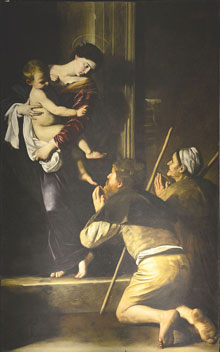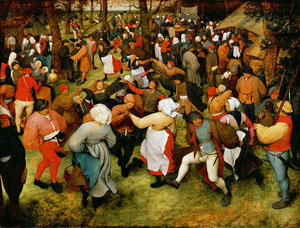Angels with Dirty Feet
John Haberin New York City
Caravaggio: Madonna di Loreto
Pieter Bruegel the Elder: Wedding Dance
With the Madonna di Loreto, Caravaggio welcomed pilgrims to the church of Sant'Agostino in Rome. In fact, he gave two of them pride of place in his painting. Not everyone around 1606 was glad to see them.
Also known as Madonna of the Pilgrims, it places them both in the foreground, facing into the painting, like extensions of the viewer. A man in humble clothing kneels so close to Mary that his hands clasped in prayer practically touch the feet of the child in her arms. A woman kneeling to his right shows every sign of aging in her face and poverty in the rag that covers her head. Both rest on the staffs of day laborers, peasants, or beggars.  More shockingly, the man's soiled and splayed feet reach toward the picture plane, where they are impossible to overlook. The entire painting, like his penury and devotion, is very much in your face.
More shockingly, the man's soiled and splayed feet reach toward the picture plane, where they are impossible to overlook. The entire painting, like his penury and devotion, is very much in your face.
Caravaggio is like that as well. He had only recently painted his Death of the Virgin, her feet bare as well and her belly swollen in disease—or in recollection of the virgin birth. Not long before, too, he had completed his first great public commissions, including his Calling of Saint Matthew and Conversion of Saint Paul, which set both events amid the low life of stablemen and cheats. The work put the Baroque itself on the map. Earlier paintings, for private audiences, reached out with the temptations of card sharps, fruit, wine, and sex. This time out, though, he rubs the face of more aristocratic viewers in the dirt.
As a postscript, how better to celebrate a birthday than with ever so many friends and neighbors—and with a dance? Make that Wedding Dance, from Pieter Bruegel the Elder in 1566. Cheryl took it as a topic for another podcast, this one on her husband's birthday. While she also showed Bruegel's Hunters in the Snow from the year before, listener comments and a mood of a celebration kept returning her to the dance. She read from the Detroit Institute of Arts, with its measured appreciation of its pleasures, but she balked at its mention of the crudity of the dancers. Was she right?
Beyond the scandal
The Madonna di Loreto has gone down as a scandal, but watch out. It is way too easy to assimilate it to modern myths—of the lone artistic genius set against tradition and the crowd. Yet Rome greeted it with applause. Another painter, Giovanni Baglione, saw a scandal in just that acclaim, but then he had his own axe to grind. He had had his rival imprisoned for libel. Caravaggio, then, was setting himself not apart, but in the midst of career, class, and culture wars.
It is easy, too, to revel in the dirt, like a child on the streets of Rome even now playing in the mud. Cheryl McGinnis featured the painting in an ambitious series of morning podcasts on Facebook, where she manages to hold the camera alone for half an hour while sharing her enthusiasm for art. She picked this one for her birthday in August, which is also the Feast of the Assumption in the Catholic Church. Cheryl stresses the plainness of Mary as well. This Madonna is not enthroned or idealized, despite her rich cloak of dark red. Front lit, she might have stepped right out of her house, perhaps just off the Piazza Navona nearby. Gian Lorenzo Bernini had not yet placed his Fountain of the Four Rivers there, on a central site since at least the Roman Empire, but it was already a busy and often sordid place.
With her loose dark hair, Italian features, and fingers spread to hold her child, Mary looks more like a portrait than an ideal, with good reason. The biographer of Guercino, another artist back then, remembers the model. "A young girl of poor but honorable family," she entered the class and culture wars herself, when her mother complained about a suitor, a notary, as destined by his profession for hell. She earned complaints, too, for her sessions with Caravaggio—complaints that caused the painter from Lombardy to retaliate with a physical assault. He did not yet have to flee the city to escape punishment for murder, on his way to southern Italy and an early death.
Mary is human enough, then, but consider. Has Caravaggio humanized the mother of a god, or has he rather elevated a common humanity to the heavens? The first seems obvious enough, in light of art's ascendant realism, and Caravaggio has taken some of the artifice and unreality out of the picture. The painting gets its title from the Loretean cult that commissioned it, and (as Catherine Puglisi notes) similar commissions place Mary not on a threshold but on the roof of a flying house. The workshop of other founders of the Baroque, the Carracci brothers, rendered just that—but not Caravaggio. And yet critics at the time worried more about whose feet belonged in high places.
Maybe Mary is not all too human after all. Earlier art had made her more human still, from her care for her child to her grief at his death. In a carving in the Cloisters in uptown Manhattan, resting on one arm while the infant sleeps, she looks downright bored. Here she sweeps in, her feet barely touching the slab on which she stands (perhaps an echo of the empty tomb of Jesus), and the diagonal ending in the bare feet brings home the sweep. As Walter Friedlaender pointed out more than sixty years ago, her pose is also slightly archaic. It echoes a statue of Mary in the very same Cavalletti Chapel.
The statue itself might have come alive—and only because the piety of beggars has brought it alive. If anything distinguishes this Madonna from others, it is their beggary. They come in place of kings or wise men, and their staffs put them in the place of the traditional shepherds and their devotion. They have bare feet because pilgrims did, to display humility and a willingness to suffer discomfort. Jesus blesses them, with the uncertain gesture of a child. Statues may not come to life again, nor angels with dirty feet and faces, but others will have made much the same pilgrimage to find out.
The dancer from the dance
For Cheryl, Pieter Bruegel depicts not mere peasants, but the likes of you and me, and she was ready to join in the dance. But could both be true, the appreciation and the caricature, and would it help to look back to a real master of caricature in the interests of art and faith? People who like Bruegel tend also to like Hieronymus Bosch—for still more anecdotal detail, with its promises of joy, threats of damnation, and endlessly creative eye. So would it surprise you if I say that Bosch, of all people, was High Renaissance, and Pieter Bruegel, for all the calm of winter for his hunters, was a Mannerist? There is a case to be made based on dates alone, with one around 1500 and the other in the late Renaissance. More likely than not, surveys of the Northern Renaissance end with him.
There is a case, too, in how they compose. Bosch has a fondness for symmetry, like any High Renaissance artist, even in heaven and hell—and he can bring figures close to the viewer with a picture perfect pyramid, as with John the Gospel writer nestled by a hill topped with angel. When Bruegel places something dead center, as with the Tower of Babel, it does not bode well.  Before you get too comfortable with the thought of Mannerism, though, he is also the earthier of the two and a pioneer of a new realism. When he does close in on an intimate space, with the Holy Family, the three kings are just plain folks, and the crowd behind them is not a royal train but gawkers. This artist loves and respects rural life, like those hunters in the snow.
Before you get too comfortable with the thought of Mannerism, though, he is also the earthier of the two and a pioneer of a new realism. When he does close in on an intimate space, with the Holy Family, the three kings are just plain folks, and the crowd behind them is not a royal train but gawkers. This artist loves and respects rural life, like those hunters in the snow.
So which is it? If the contrast of periods seems a little confusing, they were coined, after all, for Italy, and this is a very different culture and a different art. Even Bruegel's asymmetry looks ahead, by taking a painting into depth, as with the grand diagonal of the hunters. He is leading the way to the Baroque. While both are moralists, Bosch is a visionary, and Bruegel is more and more engaged with a vision of life. This and the hunters come much later than his busiest and most anecdotal paintings at that—amid the late warmth and feeling of harvest scenes and a smaller peasant wedding.
So what does he think about this celebration? Yes, he is a moralist, but then the Flemish and Dutch in the next century will be moralists, too. Do not forget the parables of excess in all those genre scenes and the rotting fruit in still life. Bruegel has matured, but he has not left Babel entirely behind—nor the battle of Carnival and Lent, the fall of Icarus, the rebel angels, or the blind leading the blind (all of which he painted). And here the dancers are, taken one by one, barely individuals. Behind their clunky strides and clumsy features, they care about little more than their partner and the moment.
While they may not care for the larger scene around them, you and I can still care, and the artist makes that possible. Wedding Dance is on the edge of chaos, much like the finances of the Detroit Institute of Arts, which should make us care that much more. A Facebook comment that tried to bring out a pattern of white lines, to my mind, only makes the chaos worse. Still, like William Butler Years in poetry, Bruegel can refuse to know the dancers apart from the dance. One source of unity is just that sense of the everyday as part of something greater. His high point of view draws on his own painting from the very same year of John the Baptist preaching, and that one is not about sinners.
Another source of stability is easily overlooked in the foreground, because of the pleasures at dead center. Neither figure to each side is moving, and their stance takes added stability from their placement, cut off by painting's frame. Last, as well as central to this forward looking observer, is color. Here Bruegel builds again on Bosch with a difference, thanks to their shared alla prima—or painting without the subtle tones of varied underpainting. The whites amount to a figure eight taking up the right half of the painting, and the orange reds surround the principal dancers with a semicircle. The peasants are sinners with no escape from this world, but they are saved by the sophistication of the Renaissance, the freshness of folk art, and the rhythms of the dance.

Caravaggio's "Madonna di Loreto" is in the Cavalletti Chapel of Sant'Agostino in Rome. Related reviews look at Caravaggio's last paintings, a questionable Caravaggio attribution, and Pieter Bruegel drawings.




